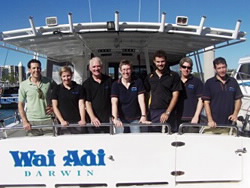ANSTO's expertise is providing a scientific basis for good environmental management in the Northern Territory's Darwin Harbour.
ANSTO's Dr Cath Hughes, Stuart Hankin and Robert Chisari recently travelled to Darwin at the invitation of the Northern Territory's Power and Water Corporation to collect data to help model currents and the dispersion of pollutants in Darwin Harbour.
 |
| The team from ANSTO with representatives from Power and Water and peers from Charles Darwin University. Pictured from left: Nic Morgan (Power and Water), Ruth Patterson & Prof Eric Valentine (CDU), Cath Hughes (ANSTO), Jordan Phasey (Power and Water),Stuart Hankin and Robert Chisari (ANSTO). |
Cath, who works as a research scientist in radiotracing and isotope hydrology at ANSTO's Institute for Environmental Research, says Darwin is an exciting study site with huge tides driving high levels of water exchange.
She explains that Power and Water, which is responsible for sewerage services in Darwin, has been working with Professor Eric Valentine and Ruth Patterson from Charles Darwin University to develop a hydrodynamic water quality modelling tool to help predict the dispersion of treated wastewater discharged into Darwin Harbour.
The model can also provide an important environmental management tool to assist environmental regulators to investigate spills and contaminated runoff from the catchment.
"Models are only as good as the data used to run and validate them and tracer studies provide the best possible data for validation," she says, "so CDU and Power and Water asked ANSTO's Isotope for Water Project to help them conduct a series of radiotracer and fluorescent tracer studies in Darwin Harbour."
Cath and her team planned and implemented the study in mid July. They used ~ 150 GBq of technetium-99m (Tc-99m) from an ANSTO Gentech™ Generator each day in combination with fluorescent tracer Rhodamine WT. The tracers were injected off an anchored boat at two different locations being considered as outfall sites. The tracers were monitored using a towed sodium iodide detector along with Rhodamine and depth sensors. The data collection strategy was optimised using onboard GPS.
An interesting result was that water at different depths was moving at different rates and the plume did not behave quite as the modellers predicted.
"This data will now be used to validate the hydrodynamic model and to determine dispersion parameters for contaminant transport."
The model will be used to optimise the location for an extension of the existing outfall at Darwin's East Point.
"Territorians love the water so it's an NT government priority to keep the harbour clean for all to enjoy. The issue has very high profile in Darwin because of public interest in the harbour, and our study attracted positive media attention," Cath continues. "This is a very successful collaboration between Power and Water, ANSTO and Charles Darwin University. We would also like to thank ANSTO Health for providing the radiotracer and the Nuclear Medicine Department at Royal Darwin Hospital."
ANSTO has been involved in radiotracing for decades, and has previously used radiotracers to successfully provide important information about current movements and dispersion in coastal environments in Jakarta Harbour and Manila Bay and to trace sewage from outfalls in Hong Kong, Sydney and Newcastle.
Posted 29 September 2010
Published: 22/09/2010


